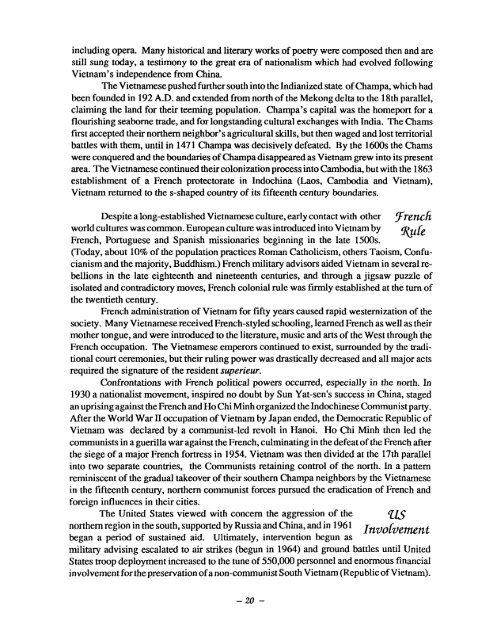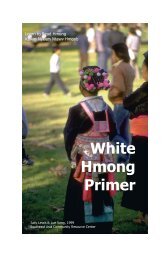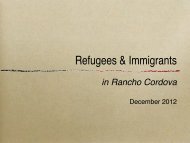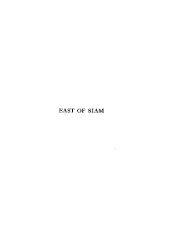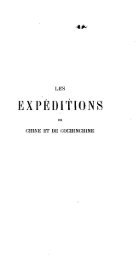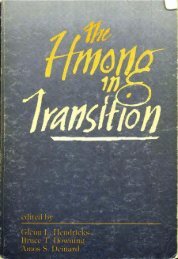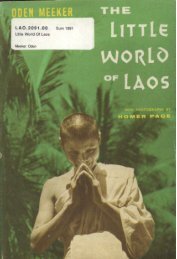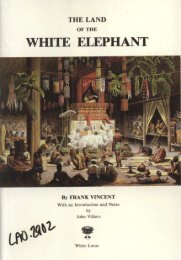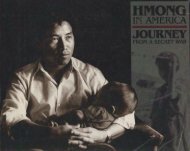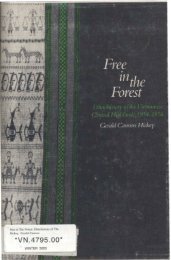and Temple Yards
iutnam From Rice Paddies and Temple Yards - Refugee Educators ...
iutnam From Rice Paddies and Temple Yards - Refugee Educators ...
- No tags were found...
You also want an ePaper? Increase the reach of your titles
YUMPU automatically turns print PDFs into web optimized ePapers that Google loves.
including opera. Many historical <strong>and</strong> literary works of poetry were composed then <strong>and</strong> are<br />
still sung today, a testimony to the great era of nationalism which had evolved following<br />
Vietnam's independence from China.<br />
The Vietnamese pushed further south into the Indianized state of Charnpa, which had<br />
been founded in 192 A.D. <strong>and</strong> extended from north of the Mekong delta to the 18th parallel,<br />
claiming the l<strong>and</strong> for their teeming population. Champa's capital was the homeport for a<br />
flourishing seaborne trade, <strong>and</strong> for longst<strong>and</strong>ing cultural exchanges with India, The Chams<br />
first accepted their northern neighbor's agricultural skills, but then waged <strong>and</strong> lost territorial<br />
battles with them, until in 1471 Charnpa was decisively defeated. By the 1600s the Chams<br />
were conquered <strong>and</strong> the boundaries of Champa disappeared as Vietnam grew into its present<br />
area. The Vietnamese continued their colonization process into Cambodia, but with the 1863<br />
establishment of a French protectorate in Indochina (Laos, Cambodia <strong>and</strong> Vietnam),<br />
Vietnam returned to the s-shaped country of its fifteenth century boundaries.<br />
French<br />
Despite a long-established Vietnamese culture, early contact with other<br />
world cultures was common. European culture was introduced into Vietnam by<br />
Kule<br />
French, Portuguese <strong>and</strong> Spanish missionaries beginning in the late 1500s.<br />
(Today, about 10% of the population practices Roman Catholicism, others Taoism, Confucianism<br />
<strong>and</strong> the majority, Buddhism.) French military advisors aided Vietnam in several rebellions<br />
in the late eighteenth <strong>and</strong> nineteenth centuries, <strong>and</strong> through a jigsaw puzzle of<br />
isolated <strong>and</strong> contradictory moves, French colonial rule was firmly established at the turn of<br />
the twentieth century.<br />
French administration of Vietnam for fifty years caused rapid westernization of the<br />
society. Many Vietnamese received French-styled schooling, learned French as well as their<br />
mother tongue, <strong>and</strong> were introduced to the literature, music <strong>and</strong> arts of the West through the<br />
French occupation. The Vietnamese emperors continued to exist, surrounded by the traditional<br />
court ceremonies, but their ruling power was drastically decreased <strong>and</strong> all major acts<br />
required the signature of the resident superieur.<br />
Confrontations with French political powers occurred, especially in the north. In<br />
1930 a nationalist movement, inspired no doubt by Sun Yat-sen's success in China, staged<br />
an uprising against the French <strong>and</strong> Ho Chi Minh organized the Indochinese Communist party.<br />
After the World War I1 occupation of Vietnam by Japan ended, the Democratic Republic of<br />
Vietnam was declared by a communist-led revolt in Hanoi. Ho Chi Minh then led the<br />
communists in a guerilla war against the French, culminating in the defeat of the French after<br />
the siege of a major French fortress in 1954. Vietnam was then divided at the 17th parallel<br />
into two separate countries, the Communists retaining control of the north. In a pattern<br />
reminiscent of the gradual takeover of their southern Champa neighbors by the Vietnamese<br />
in the fifteenth century, northern communist forces pursued the eradication of French <strong>and</strong><br />
foreign influences in their cities.<br />
The United States viewed with concern the aggression of the 'Us<br />
northern region in the south, supported by Russia <strong>and</strong> China, <strong>and</strong> in 1961<br />
began a period of sustained aid. Ultimately, intervention begun as<br />
military advising escalated to air strikes (begun in 1964) <strong>and</strong> ground battles until United<br />
States troop deployment increased to the tune of 550,000 personnel <strong>and</strong> enormous financial<br />
involvement for the preservation of a non-communist South Vietnam (Republic of Vietnam).<br />
~ ~


